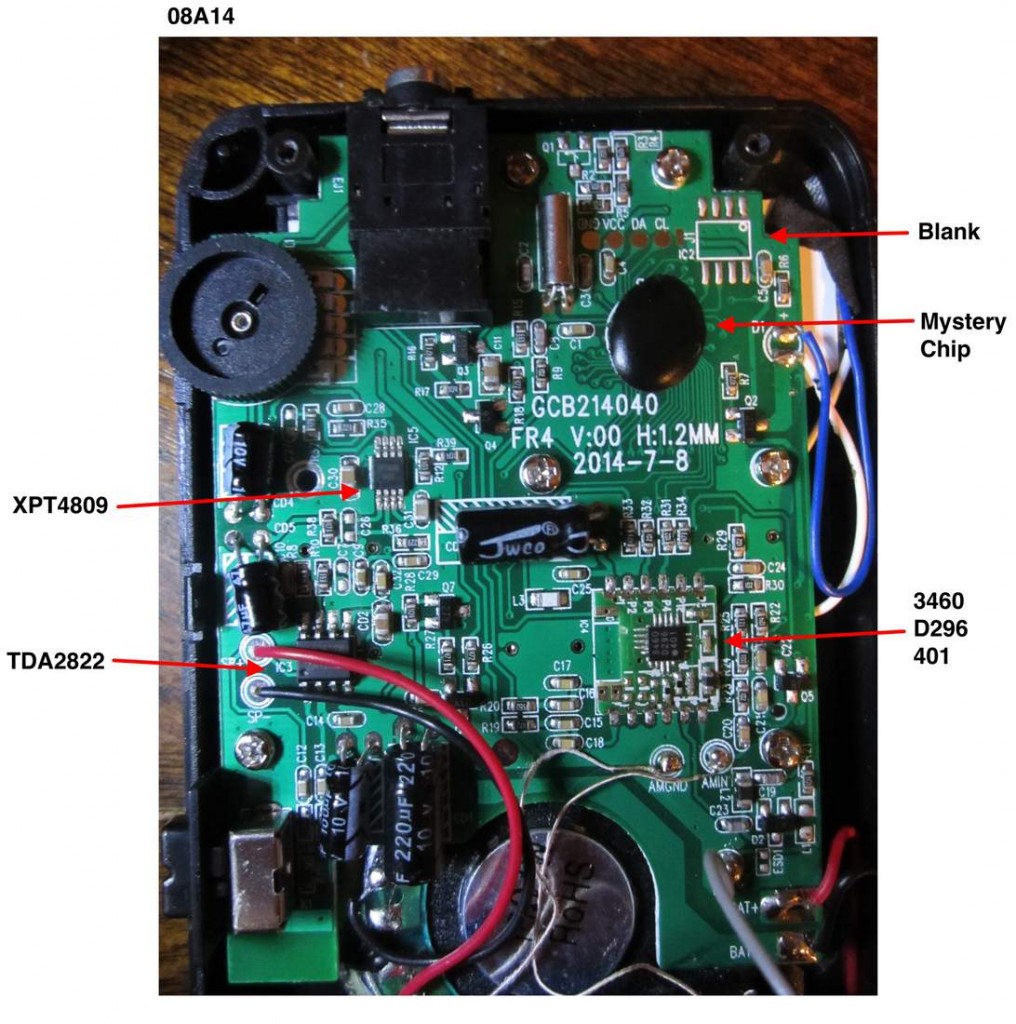After submitting his mini review of the RS Model 2000669, SWLing Post reader, Mike, writes:
Attached [above] is an annotated photo of the RS radio’s PC board.
As you’ll see, there is a mystery “blob” chip, which probably handles the DSP functions.
The TDA2922 is an audio amplifier, but I couldn’t find data sheets for the other ICs. Maybe some of your readers can help.
There is one pad prepared for an additional chip, so additional functions might be possible. By the way, I discovered that if you remove the batteries, the memories and clock have to be reset; which is unfortunate. Overall, for $30, I’m quite happy.
Mike, thanks so much for cracking open your brand new radio so that we can take a look inside. The “blob” chip does most likely handle DSP and I bet it’s not a SiLabs chip since (I believe) they are typically labeled. Perhaps readers can chime in with additional information?
Update: I stand corrected. K.U. comments:
“The radio has an Si4734:
Line 1: 3460 = Si4734, firmvare rev. 6.0
Line 2: D296 = Revision D die, tracking code 296
Line 3: 401 = Last significant digit of the year, workweek
Reference: https://www.silabs.com/Support%20Documents/TechnicalDocs/Si4730-31-34-35-D60.pdf (See page 37)”


What is IF frequency for 2000669 ? Is it a direct conversion on SW with a zero (audio)IF or low IF around 12 kHz ? Would like to add a BFO.
The models shown here are what are known as “Software Defined Radios”. They use a VCO under control of a DSP processor and convert the signal to a low frequency or even base band. The DSP engine inside the chip then applies decoding as needed so there is no need for a BFO or a PLL or Stereo Decoder. They interface the low frequency output of the mixer straight to a set of A/D converters that are set up in an I/Q format. One signal for one mixer is 90 degrees off from the other.
Would anyone here know how to modify the internal components in order to continuously sweep through the channels unmuted; picked up this radio in hopes of making a spirit box for ghost hunting, but unfortunately can’t make heads or tails of this model.
That is indeed an Si4734. I recognized the peculiar little sub board the chip is mounted on. You can find it online for projects and it’s a favorite of the Arduino crowd 🙂
You can see a typical Chinese supplier here: http://www.alibaba.com/product-detail/SI4730-V2-0-FM-AM-dual_1926122201.html
The mystery chip may be a bare die PIC processor of some sort and IC2 is wired for a serial flash chip (24C01 through 24C32). I suspect the PIC, possibly a 16F or 18F family, as this is perfect for controlling an LCD and has an SPI/I2C port to control the Si4734. The 32K clock this card uses is supplied by the CPU and I think that’s why it’s not installed. Why waste a good crystal?
The XPT4899 is wired to the headphone jack and is working as a dual channel driver as it’s designed for a 32 Ohm load. A datasheet is here: http://www.chinesechip.com/chip/documents/c69e500de6ba4df1bfb438c60dd37ade_0.pdf
This is important as the DSP radio inside the Si4734 is outputting in stereo.
The TDA2822 is wired as a bridged driver just for the little speaker as this is the best way to do this when running on 3V. A datasheet can be found here: http://www.mouser.com/catalog/specsheets/stmicroelectronics_cd00000134.pdf
The radio has an Si4734:
Line 1: 3460 = Si4734, firmvare rev. 6.0
Line 2: D296 = Revision D die, tracking code 296
Line 3: 401 = Last significant digit of the year, workweek
Reference: https://www.silabs.com/Support%20Documents/TechnicalDocs/Si4730-31-34-35-D60.pdf (See page 37)
K.U., thanks for the info. Looking at the data sheet, this chip has a lot of capabilities not implemented in this radio (too bad). Maybe a hacker’s challenge? Still, for the money, I’m happy with it: it has become the radio I listen to every morning while walking the dog.
Thanks, Mike